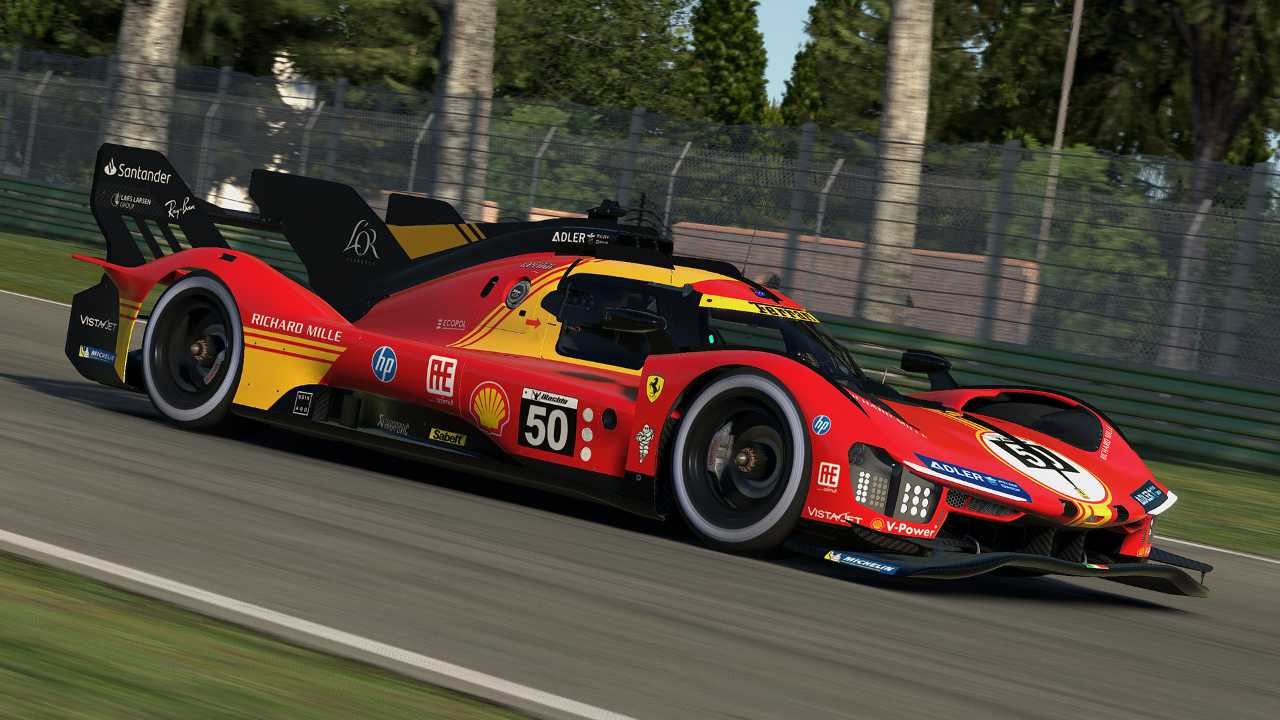The iRacing Prototype Challenge is an all-prototype sprint-style series that was introduced to the service relatively recently. Unlike other prototype series, it is a one-class series that is technically a little deeper than that.
The Cars

The series comprises prototypes from multiple manufacturers that may be broken down into two sub-classes:
LMDh
- Acura ARX-06
- BMW M Hybrid V8
- Cadillac V-Series.R
- Porsche 963
LMH
- Ferrari 499P
All of the cars are prototypes built around a carbon fibre chassis with double-wishbone suspension and relaively high downforce aerodynamics. The cars feature a variety of engines in both turbo-charged and naturally aspirated configurations.

All of the cars feature hybrid technology, where electrical energy is generated under braking and then used to charge a battery. The battery can thereafter be used to supplement the internal combustion engine to provide improved efficiency. In total, this power, regardless of whether it is from the internal combustion engine or battery, will be sent through the rear wheels for the LMDh cars.
The Ferrari, unlike the other four cars, is an LMH, which means that the electrics can power the front wheels at 180 km/h and above. This four-wheel drive mode is, of course, a significant performance advantage over the rear wheel drive cars. However, the Balance Of Performance (BOP) used to keep all of the cars at similar performance levels regardless of configuration tends to negate this advantage.
Race format and strategy
As we touched on earlier, races in this series are 20 minutes long without any stops for fuel or tyres. The emphasis is therefore placed on outright pace with very little to worry about in terms of tyre and fuel management.

You will need a Class B Sports Car Licence to race in the iRacing Prototype Challenge. Races begin from a double-file rolling start with the first lap, as usual, being vital for not only achieving a good result but for just surviving the race in general.
This is a fixed setup series, so you will need to focus more on consistency and pace instead of making setup adjustments.
Car Setup and Practice
Even though this is a fixed setup series, the brake bias can be adjusted from the cockpit during the race and qualifying.
We highly recommend that you try out this setting in practice to gather an understanding of how it can be used to improve the balance of the car. For example, moving it forward can improve straight-line braking performance at the cost of possible understeer.
Moving it rearward can help with turn-in rotation but can reduce your stopping power and may induce unwanted oversteer. Mapping this setting to your steering wheel to allow for per-lap adjustments may be the best way to manage this setting.
We suggest that you spend a good number of laps in practice to give you time to learn the effects of dirty air when following a car closely. You can also use this time to practice your brake bias adjustments and improve on your qualifying pace.

One thing you will have to be careful of in all sessions is cold tires. iRacing introduced this recently, where the tyres are quite cold when leaving the pits because the real-life cars do not use tyre warmers. You will have to be careful on the throttle and brakes for the first lap or two before pushing. We found that you can crank the steering wheel quite a bit at low speed under throttle to force the car into understeer and thereby generate some heat energy under load. This is not ideal, but you will need to practice this to gain the maximum advantage from it.
None of the cars enjoy being pushed very hard. Unlike the F4 single seater, these cars do not like being exploited at the limit with a high slip angle. It is far better to be smooth under braking, throttle and steering inputs than trying to slide the car around in the vain hope of gaining a small amount of lap time. Sliding the rear normally causes the Traction Control to kick in, and this normally kills your forward momentum.
Which car is the best?
The BOP employed by iRacing prevents any one car from gaining any lasting advantage. Each car is different with good and bad points. We love the Cadillac because it sounds amazing with that big, booming, naturally aspirated V8 and its relatively balanced handling. The Ferrari is also a car we jump into time to time because it sounds incredible under braking with the whine of the electric motors.
However, for most people, any one of the five cars can result in a winning performance.
Final thoughts
These hybrid cars feature engine modes that can be adjusted during the course of a lap. We recommend that you leave this setting in the Balanced Mode default and only consider switching to a faster mode if you're desperate for position or on the final lap.
The reason for this is that the time loss incurred when the car attempts to recover the lost energy from running in a higher performance mode negates whatever lap time advantage you may have gained. However, sometimes, a gain in track position may outweigh this in the context of the race.
We see the iRacing Prototype Challenge as a feeder series for the IMSA Series. It allows you to race prototypes with only a B license and without the challenge of having to navigate through those pesky GT3s. This series is, therefore, a natural progression towards the IMSA series, where you will find a greater challenge.

